Displays
A television tube, which is a special form of cathode ray tub (CRT), is a glass vacuum tube shaped like a funnel.
Electrons
charged particles
How does CRT work?
electrons fly through electronic controlled, time-varying magnetic fields that focus and seep the electron beam across the inside of the wide end of the tube. The interior surface of the screen is coated with phosphors, which glow when struck by electrons
Fields
525 closely-spaced lines.
Odd fields
The electron beam first writes the odd fields within 1/60 of a sec
Even fields
After the odd fields are written the electron beam writes the even fields within 1/60 of a sec or 60 Hz
Frame
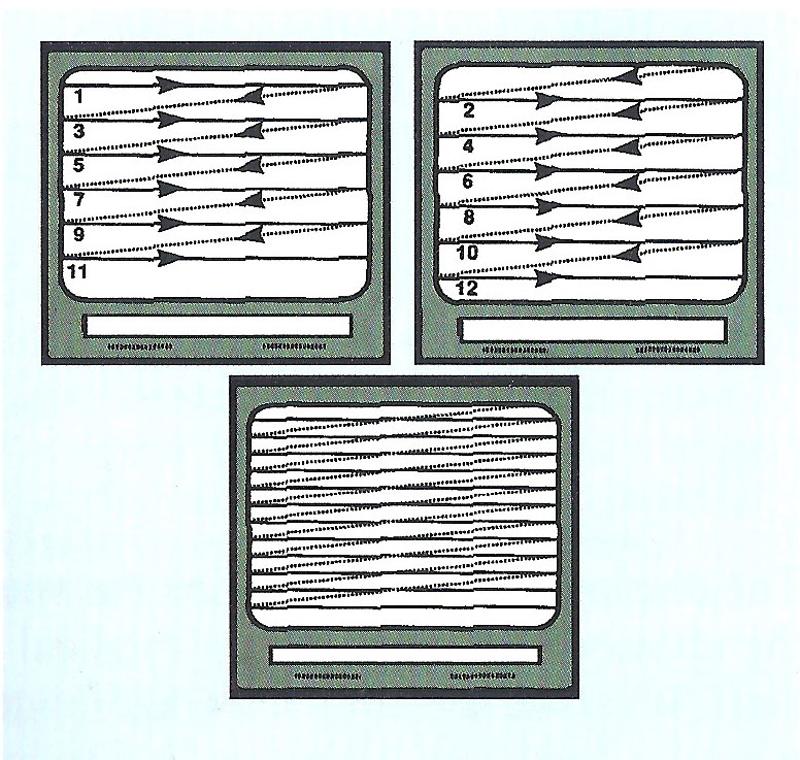
is the combination of one odd field and one even field
time is 1/30 of a second or 30 HZ or 60 Hz
interlaced
the way television are written with odd and even fields
Why are CRTs interlaced?
Humans can detect flicker in non-interlaced displays with frame rates 30 Hz, but not with an interlaced field of 60 Hz
Bistable
Bi means 2
bistable images are composed of only two shades Black and White
Grayscale
present multiple levels of grey
white, light grey, dark grey etc.
contrast
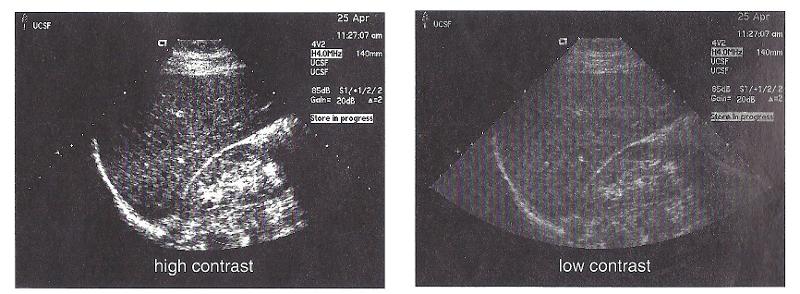
user control
determines the range of brilliances within the displayed image.
High contrast
bistable images with only black and white
Brightness
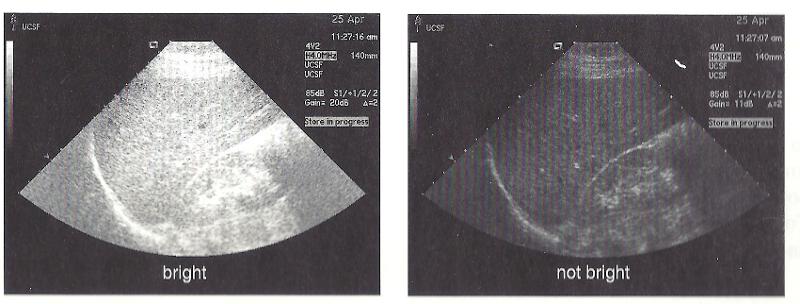
determines the brilliance of the displayed image.
Scan converter
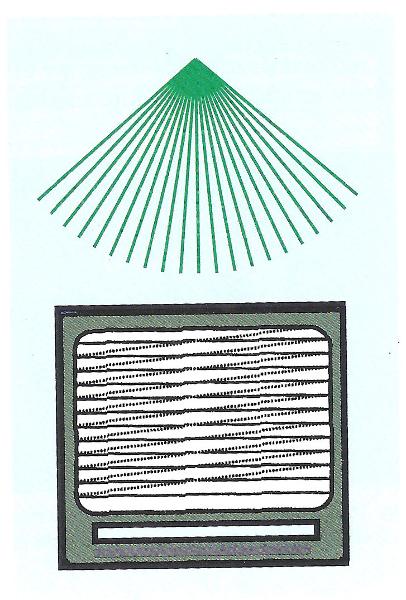
store information and later display
The scan converter translates the information from the spoke format into the video format.
writing
storage of the image information
read
image information is converted from the scan converter for display on CRT
Digital Scan converters
scan converters that use computer technology rather than older analog
Analog numbers
real world
unlimited # of choices
continuous value
Digital numbers
computer world
limited choices
discrete values
matrix
picture divided into millions of tiny dots, each containing an electrical storage item. The electrons stored in the bucket are read to retrieve the image.
silicon wafer
dielectric matrix
matrix at the larger end of CRT tube where images are stored
Spatial resolution
image detail
excellent - large number of storage units within the matrix
Limitations of analog scan converters
Image fade - stored charges on the silicon wafer dissipate over time
Image flicker - caused by switching between read and write modes
instability - picture quality depends on many factors including length of use, room temp, and humidity
Deterioration - image degrades as the device ages.
Advantages of digital scan converter
Uniformity - consistent grayscale quality throughout the image.
Stability - does not fade or drift
Durability - not affected by age or heavy use
Speed - nearly instant processing
Accuracy - error free
Pixel
picture element
smallest building block of an element
Pixel Density
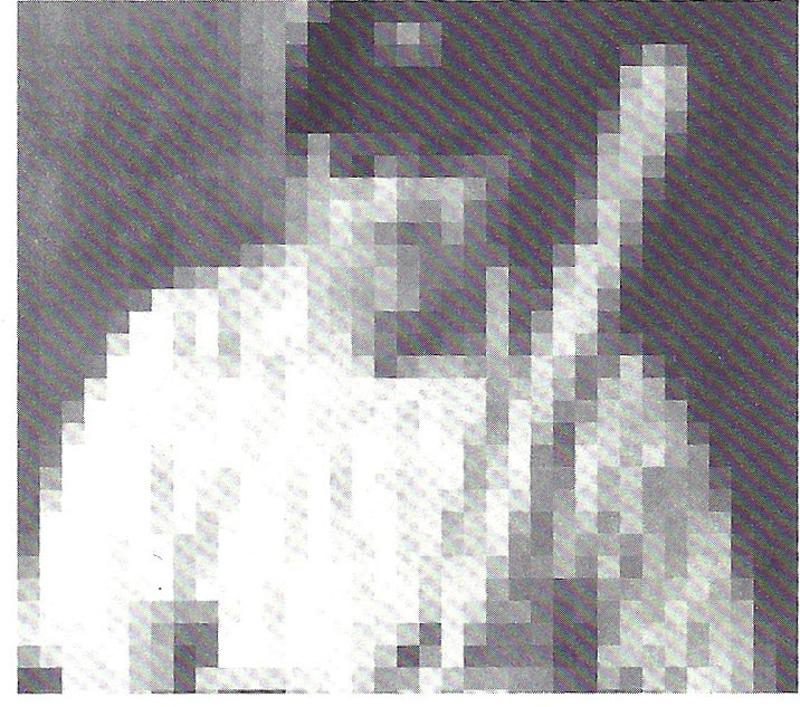
is the # of pixels per inch
improves with Higher pixel denesity
Spatial resolution
Low Pixel Density vs. High Pixel Density
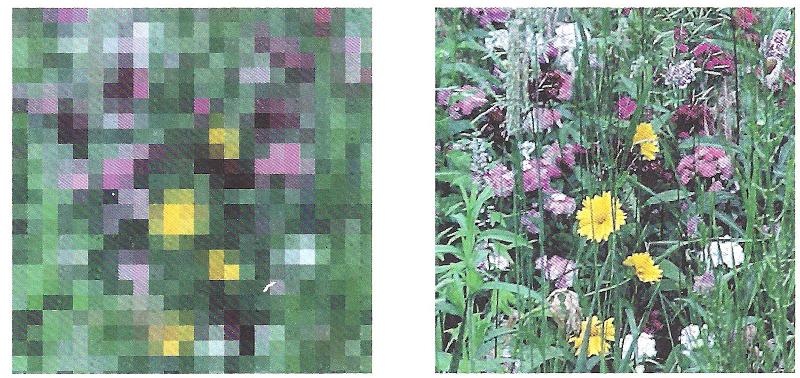
Low Pixel Density
-few pixels/inch
-larger pixel
-less detail image
-lower spatial resolution
High Pixel Density
-many pixels/inch
-smaller pixel
-more detail image
-higher spatial resolution
Bit
is the smallest amount of computer memory
a bit is bistable, having values of either 0 or 1
Binary Number
is a group of bits and is simply a series of zeroes and ones
0101010011
Decimal numbers
used in everyday life are based on ten choices 0 through 9
byte
is a group of eight bits of computer memory
10011111
word of computer memory
made up of two bytes or 16 bits
Fewer bit per pixels
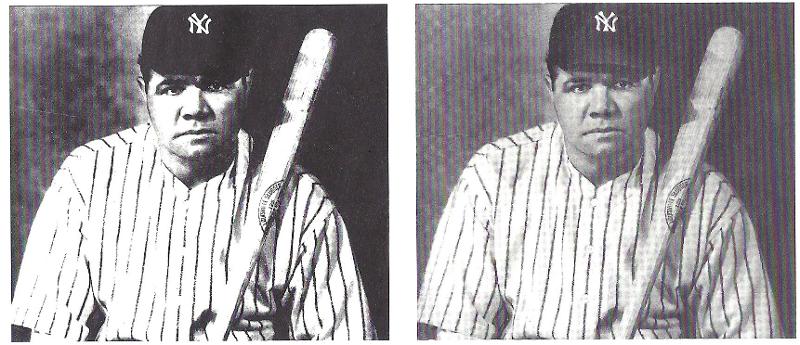
fewer shades of grey
degraded contrast resolution
more bit per pixels
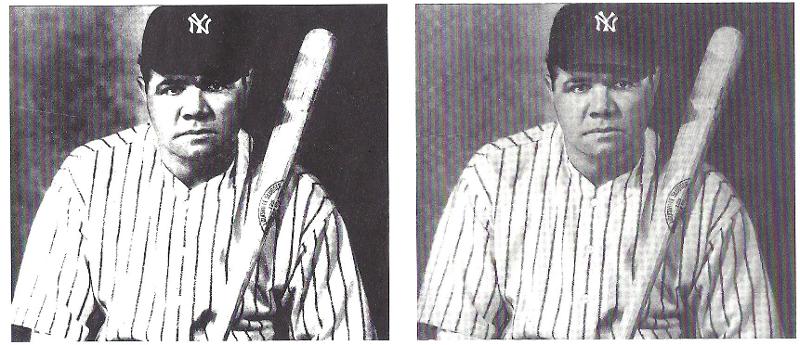
more shades of grey
improved contrast resolution
Calculating the number of gray shades
raise 2 by the power of (# of bits)
What is the number of shades that can be represented by 3 bits?
8 different shades of gray
2 * 2 * 2 = 8
What is the number of shades that can be represented by 8 bits?
256
2 * 2 * 2 * 2 * 2 * 2 * 2 * 2 = 256
2^8
How many bits are needed to store 10, 11, and 15 shades of grey?
4
4 bits are required to store 9 to 16 shades of grey
Analog and digital image information
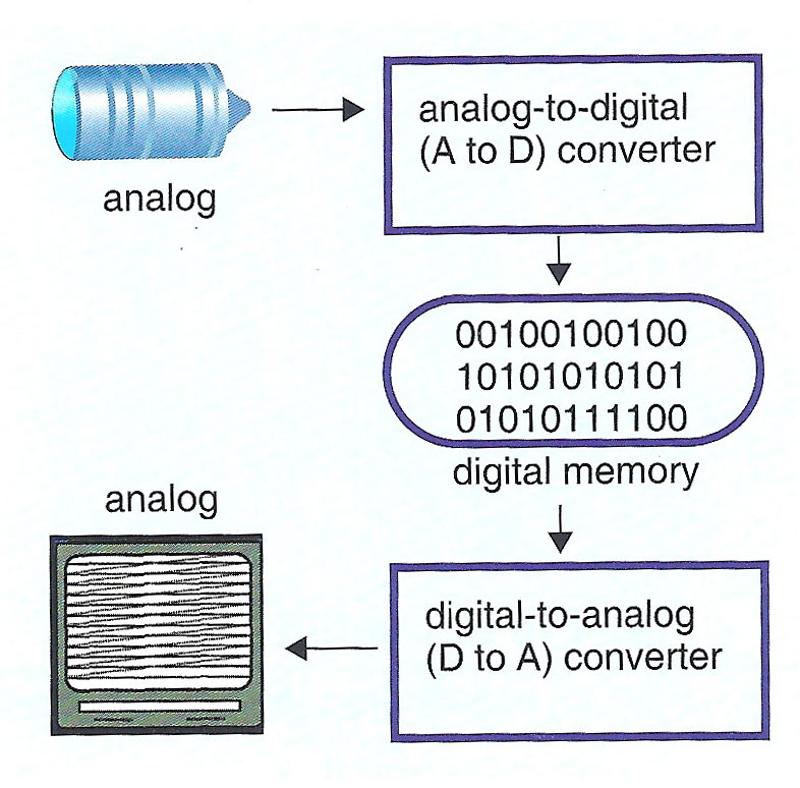
1. converted from analog to digital for by the analog-to-digital scanner (A-to-D)
2. The digital information is stored in the scan converter's computer memory. Preprocessed
3. processing continues after storage
4. digital signals converted back to analog by a digital-to-analog converter (D-to-A)
5. signal is presented in the video display.
Preprocessing
any processing of the electrical signals before storage
Can the sonographer control preprocessing?
yes
time gain compensation
log compression
write magnification
Is preprocessing reversible?
No
Postprocessing
any processing after storage in the digital scan converter
Can a sonographer control postprocessing?
yes
is post processing reversible?
yes
any change after freeze frame
black/white incersion
read magnification
contrast variation
magnification
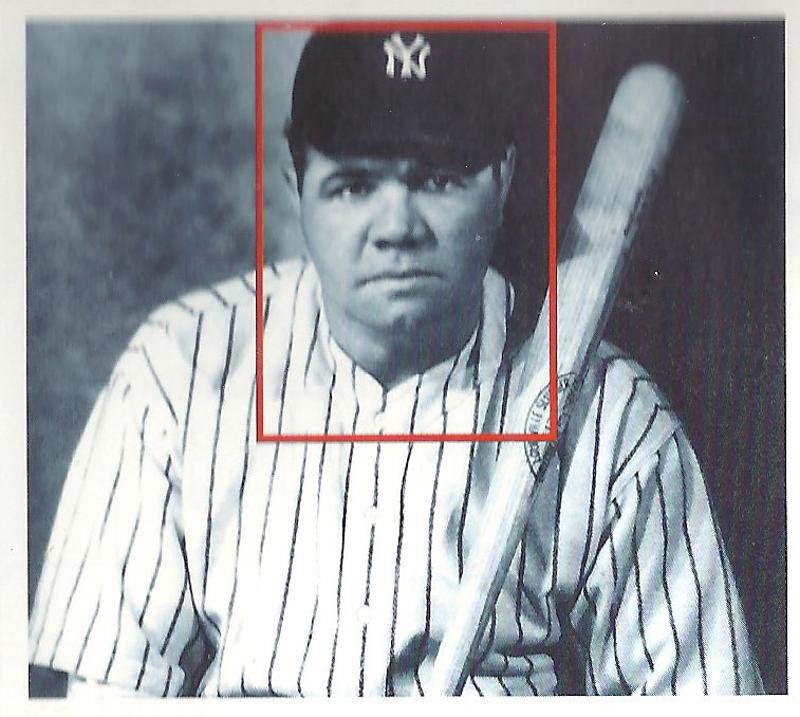
enlarging a portion of an image to fill entire screen
ROI
region of interest
Read magnification
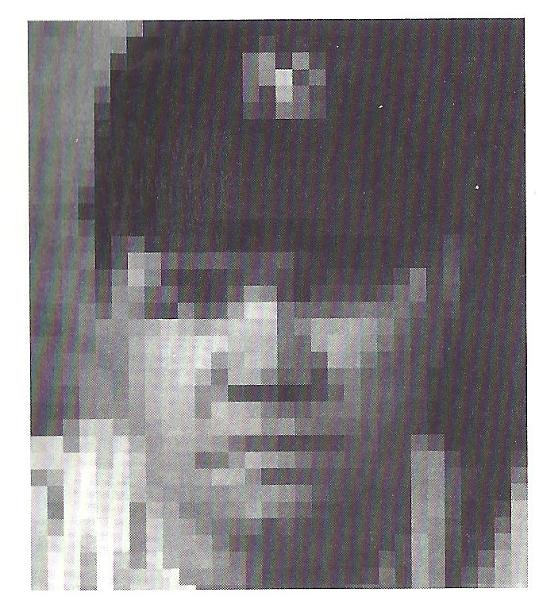
occurs after storage in the scan converter
the system reads and displays only the original data pertaining to the ROI
* Spatial resolution is not changes because the number of pixels is unchanged
Write magnification

applied during data acquisition, before storage in the scan converter
1. scans an image
2. converted and stored
3. ROI identified
4. image discarded re-scan only the ROI and writes new data
increased number of pixels in the image improves spatial resolution
Can write magnification improve temporal resolution?
yes if the ROI is shallower than the original image's DOV
Read magnification vs. write magnification
Read magnification
-uses old data
-post processing
-larger pixels
-same # of pixels
-unchanged spatial resolution
-unchanged temporal resolution
Write magnification
-uses new data
-pre processing
-smaller pixels
-more pixels
-improved spatial resolution
-possible improved temporal resolution
Paper Media
Examples
-charts from pen writers
Advantages
-portability
-does not require device to read
Disadvantages
-bulky, hard to store
-difficult to make copies
-cannot display dynamic images
Magnetic Media
Examples
-CD
-computer memory
-magnetic tape
-video tape
Advantages
-can be erased by strong magnetic fields
-store huge amounts
-can store and play dynamic images
-can record color
Disadvantages
-can be erased by magnetic field
Chemically mediated photographs
Examples
-photographs
-flat film
-multiformat camera film
Advantages
-high resolution
-accepted in the medical community
-can produce color images
Disadvantages
-bulky, hard to store and retrieve
-requires chemical processing
-atifacts can arise from dirt or chemical contamination
Optical Media
Examples
-laser disc
-compact disc
Advantages
-store huge amounts
-inexpensive
-not erased by exposure to magnetic field
Disadvantages
-require a display system
-No standardized format for image display and storage
What is a PACS system?
picture archiving and communications system
describes the digital ultrasound laboratory in which images and reports are digitized and stored on a large computer network.
PACS advantages
instant access
no degradation
store and forward
What is magneto-optical storage?
Magneto-optical, or M-O storage is based on a combination of magnetic and laser (optical) technology. PACS often uses M-O disc storage.
M-O Storage advantages
store large amounts
high degree of security - not erased by magnetic field
All of the following are true of ordinary cathode ray tubes except:
A) it contains large vacuum tubes with a phosphor-coated screen
B) Electrons are emitted by a gun and swept across the screen by varying magnetic fields
C) There are 600 horizontal scan lines from top to bottom, painted in order from 1 to 600
D) There are 60 fields generated each second that combine into 30 frames per second
C) There are 600 horizontal scan lines from top to bottom, painted in order from 1 to 600
normal CRT creates images using 256 horizontal scan lines that appear on the screen iin an interlaced format
Which of the following correctly describes a typical television display?
A) interlaced
B) progressive scan
C) bistable
D) non-interlaced
A) interlaced
Which electronic component is required for grayscale imaging?
A) VCR
B) non-interlaced
C) computer memory
D) scan converter
D) scan converter
All of the following are disadvantages of analog scan converters except:
A) image fade
B) low-resolution image
C) image filter
D) deterioration
B) low-resolution image
Which of the following scan converters will provide the best spatial resolution?
A) digital with 256 x 256 pixels
B) digital with 512 x 512 pixels
C) digital with 128 x 128 pixels
D) digital with 1000 x 1000 pixels
D) digital with 1000 x 1000 pixels
How many gray shades can be represented by a group of
* 4 bits?
* 2 bits?
4 bits = 16 shades
2 * 2 * 2 * 2 = 16
2 bits = 4 shades
2 * 2 = 4
Which of the following statements regarding a pixel is false?
A) smallest part of a digitized image
B) a collection of bits, assigned to each pixel, stores the shade of gray.
C) it displays up to 3 gray shades, simultaneously
D) image quality is improved when the number of pixels is high
C) it displays up to 3 gray shades, simultaneously
Are the following procedures usually pre- or post-processing?
A) modifying a frozen image
B) read zoom
C) write zoom
D) adjusting the brightness on the CRT
E) increasing the receiver gain
post A) modifying a frozen image
post B) read zoom
pre C) write zoom
post D) adjusting the brightness on the CRT
pre E) increasing the receiver gain
Are the following forms of information usually digital or analog?
A) the signal from the transducer to the receiver
B) the input signal to the digital-to-analog
C) the output signal from the analog-to-digital
D) the input signal to the analog-to-digital
E) the output signal from the digital-to-analog
F) a typical video signal
analog A) the signal from the transducer to the receiver
digital B) the input signal to the digital-to-analog
digital C) the output signal from the analog-to-digital
analog D) the input signal to the analog-to-digital
analog E) the output signal from the digital-to-analog
analog F) a typical video signal
All of the following are characteristics of write magnification except:
A) pre-processing function
B) more pixels in the region of interest
C) identical regions stored in the scan
D) it is the preferred method of image magnification
C) identical regions stored in the scan
What is the primary disadvantage of video tape and computer disc methods of image archiving?
A) these methods are very costly
B) the information is vulnerable
C) only low resolution images are stored
D) only black and white images are stored
B) the information is vulnerable
All of the following are advantages of PACS systems except:
A) data will not deteriorate over time
B) images can be delivered to distant locations on the imaging network
C) older, achieved studies and reports can be reviewed easily
D) images have higher resolution than what appears on the system's display
D) images have higher resolution than what appears on the system's display